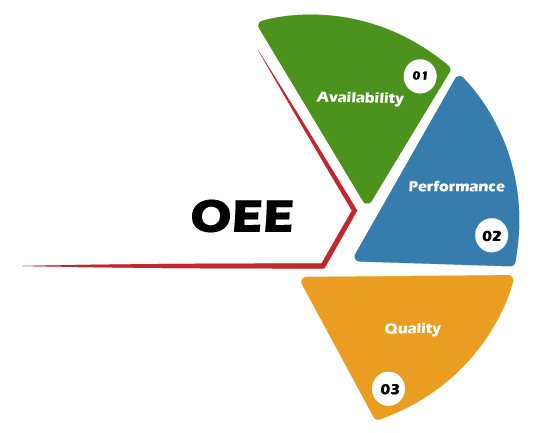Overall Equipment Effectiveness
Overall Equipment Effectiveness (OEE)
Overall equipment effectiveness is a software development metric used to diagnose a product or machinery's manufacturing productivity and effeteness.
The term OEE was introduced by Seiichi Nakajima San in the 1960s to evaluate the manufacturing operations (how effectively these operations are utilized).
OEE is not a measurement tool, but it is a diagnostic tool that monitors and improves the manufacturing process's effectiveness, including assembly lines, manufacturing cells, and machines.
OEE is used as a critical metric in Lean Manufacturing programs and total productive maintenance (TPM). It also helps reach "zero defect production," and provides essential input for continuous improvements.
Key factors of OEE
- Availability
- Performance
- Quality

Availability – Availability is the ratio of operating time to the planned production time. It tells about the actual availability of machines for the production out of total available.
Availability = Operating Time / Planned Production Time
Operating time = Planned production time – Downtime
Availability = Available time – Downtime / Available time
Downtime = Losses time, Breakdown, repairs, changeover and setup adjustments, etc.
For example, machine shift is of 12 hours and out of which 1 hour is planned stoppage and 1 hour is an unplanned stoppage, so actual production time is 10 hours, So
Availability : Actual runtime / total available time = 12/ 10 = 0.83
Performance:- Performance is the ratio of Net Operating time to the Operating time. Performance is all about the speed of the machine.
Performance = (Ideal cycle time * total pieces) / Operating time
Or
Performance efficiency = running time- performance loss/ operating time.
Losses = idling or small stops and reduced speed
For example:- For actual production time of 10 hours machine can produce 1000 pieces as per standard cycle time, but it produces only 800 pcs, So
Performance: Actual production quantity / Planned production
800 / 1000 = 0.80
Quality:- Quality is the ratio of good pieces produced to the total pieces produced. It answers, "how much good quality of material produced during the production?”.
Quality = Good Unit Produced/ Total unit produced
Or
Quality = productive time- quality loss time / productive time
Or
Quality = Total qty. produced – defective quantity / total quantity produced
Losses- Start-up rejects, and production rejects
For example: Out of the Actual produced 800 pcs, 760 pcs are of good quality (acceptable to customer), 20 pieces rejected, and 20 reworked
Quality = Okay pieces/ Total produced quantity
Quality = 760/ 800 = 0.95
Therefore, machine availability is 83%, performance is 80%, and quality is 95% but now what overall equipment effectiveness is?
How to calculate OEE?
OEE = availability * performance * quality

OEE = 0.83 * 0.80 * 0.95
OEE = 0.63 = 63%
Purpose and benefits of overall equipment effectiveness
- Determine the six big losses
The main purpose or goal of OEE is to identify and reduce the six big losses of total productive maintenance (TPM)
The most common causes of equipment-based productivity loss in manufacturing are SSSMCB (6 Big Losses)
| Quality | S | Scrap Loss |
| Quality | S | Start-up Loss |
| Performance | S | Speed Loss |
| Performance | M | Minor stoppages |
| Availability | C | Changeovers |
| Availability | B | Breakdown |
With these six significant losses, we can find out about the current significant losses in our machine. These losses have a significant impact on machines; therefore, with this, we can measure them, control them, and down them very quickly.
.
- It helps in reducing the quality costs
- Improves plant productivity
- Downtime costs are reduced
- Being an efficient and most effective manufacturer in the market
- Increase labor efficiency
- The repair cost is reduced
Methods used to increase OEE
Data collection is a fundamental basis to increase OEE, and this has been divided into three phases.
- Collect data for all downtime and losses on the machine.
All the changes happening in the machine are collected in this:
- Change due to repairs
- Change over adjustment
- Tool change
- Minor stoppages
- Scrap, rework
- Data analysis and visible measure
In this, data is analyzed and prioritized. The top contributed factor is identified, and action is initiated on the factor. We can also monitor the trend of overall equipment effectiveness.
- Make improvement visible and implement
In this, actions are implemented and could be visible. Actions can be like:-
- Standardization
- Kaizen
- Standardize tooling
- Changeover reduction
- Preventive maintenance
- Autonomous maintenance
- Improved machine reliability